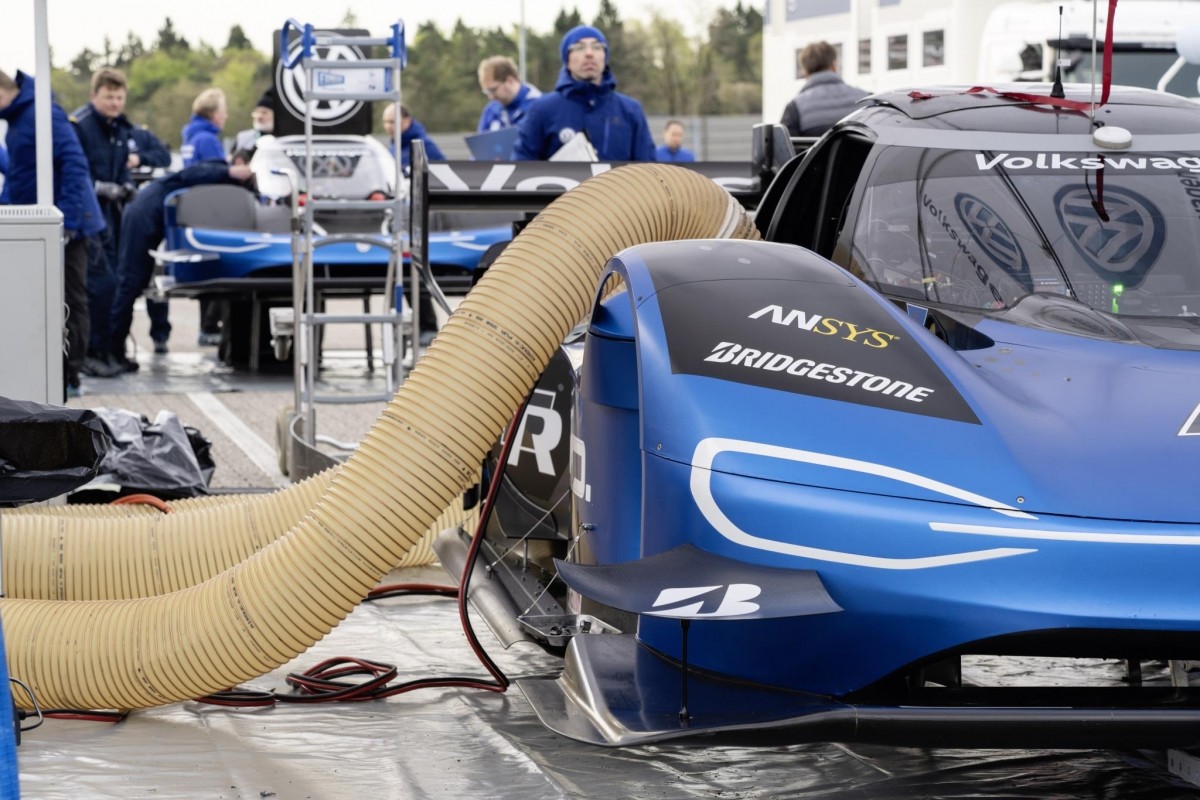Volkswagen achieves another milestone in electro-mobility
Update 3.6.2019:
Volkswagen has achieved another milestone in electro-mobility: The ID.R, powered by two electric motors, lapped the Nürburgring-Nordschleife in 6:05.336 minutes – faster than any electric vehicle before it. French driver Romain Dumas beat the previous record set by British driver Peter Dumbreck in the NIO EP9 in 2017 by 40.564 seconds. With an average speed of 206.96 km/h (128.59 mph), the ID.R once again underlined the impressive performance capabilities of Volkswagen’s electric drive. This 500 kW (680 PS) emission-free race car is the racing flagship of the future fully electric ID. product family from Volkswagen.
Within just 12 months, Volkswagen Motorsport has already set three track records with the ID.R. On 24 June 2018, Dumas achieved the absolute track record of 7:57.148 minutes at the renowned Pikes Peak International Hill Climb (USA). Just three weeks later, he achieved a new best time for electric cars of 43.86 seconds at the Goodwood Festival of Speed in southern England. The new record on the legendary Nordschleife has now been added to this successful run.
To prepare for the Nürburgring Nordschleife challenge, in just five months Volkswagen Motorsport gave the ID.R a complete makeover compared to the record outings on Pikes Peak and in Goodwood. “For this evolved version of the ID.R, the aerodynamic configuration was more strongly adapted to the highest possible speed, rather than maximum downforce,” explained Technical Director François-Xavier Demaison,. “With extensive test laps in the simulator and on the race track, we adapted the ID.R to the unique conditions of the Nordschleife, focusing mainly on chassis tuning, energy management and optimal choice of tyres for the record attempt.”
The ID.R’s centre of gravity is much lower than a normal race car due to the fact that the battery package is at the bottom of the car. This allows for very high cornering speeds, which can only be achieved if the tyre is able to transfer the vehicle’s power potential onto the road’s surface. Another challenge, specific to electric vehicles (EVs) – that is especially present in the ID.R – is the extremely high torque on the wheel. Meaning that the ID.R’s tyres must have a strong grip performance in both lateral and longitudinal directions.
The ID.R is also engineered with a perfectly aligned suspension and load balance, to put equal stress on all four tyres. This allows longer durability in the tyres but, at the same time, requires the tyres to efficiently attain heat. Finally, the tyres need to be durable enough to allow for the required operating range to create successful record attempts.
With vast experience in motorsports, Volkswagen looked to Bridgestone and its sports tyre range, Potenza, to support achieve the ID.R record attempt.
The Bridgestone Motorsports team began its collaboration with Volkswagen by assessing specific needs and requirements of Volkswagen, before testing and evaluating the resulting test data and, finally, across the R&D Centres of Bridgestone in Rome and Japan, developing a set of exclusive Potenza slicks for the ID.R. The slick tyres overcome the ID.R’s unique challenges to give optimal performance and confidence on the track – ensuring that the electric supercar could use its full power on all of the Nürburgring’s 20.83-kilometre surface.
Due to the open-minded and transparent collaboration between both companies, the project was completed in less than five months – a record time.
The joint project has provided Bridgestone and Volkswagen with a better understanding of the specific challenges related to electric vehicles on and off the race track. Bridgestone can apply its findings in material development and composition, as well as entire configuration optimisation from this project to better the business’s growing EV tyre segment.
“We’re so proud to be part of this historical moment and contribute to the record on the Nürburgring-Nordschleife,”said Mark Tejedor, Vice President Original Equipment at Bridgestone EMEA. “Reducing CO2 emissions and improving natural resource preservation are essential pillars of ‘Our Way to Serve’, the Bridgestone sustainability strategy. It’s great to work on a project that not only contributes to bringing those to life but does so in a world record time. Just a few short years ago, no one would have predicted that EVs could achieve something like this. Our next step will be to apply the findings from this amazing partnership to EVs on the roads to benefit all drivers.”
For Dumas, who is a four-time winner of the 24-hour race at the Nürburgring, the record lap with the ID.R is another highlight on his favourite track. “To be a record-holder on the Nordschleife makes me unbelievably proud,” he said. “For me, this is the best and most difficult race track in the world. I want to thank the team at Volkswagen Motorsport who have once again done a fantastic job. The ID.R was perfectly prepared for the Nordschleife and it was so much fun to experience the blistering acceleration and rapid cornering speeds.”
30.5.2019: As Volkswagen sets out to break the lap record for an all-electric car at the 20.8-kilometre Nürburgring-Nordschleife, it has highlighted the challenges involved.
“To drive a whole lap of the Nordschleife with full performance is a huge challenge for electric drive,” says François- Xavier Demaison, Technical Director of Volkswagen Motorsport. “Therefore, optimal charging before the lap begins, along with the recuperation when driving, are of crucial importance.”
To this end, driver Romain Dumas will have to deploy the full system performance of 500 kW (680 PS) on the three-kilometre ‘Döttinger Höhe’ section at the end of the Nordschleife, which is nearly dead straight.
Marc-Christian Bertram, Head of Electrics and Electronics at Volkswagen Motorsport, continues: “The ID.R’s battery has a particularly high power density. It is not maximum range that’s required, but rather the highest possible power output. That is why we chose a lithium-ion battery consisting of eight modules with 56 cells each, divided into two blocks next to the driver and behind the monocoque.”
The battery system of the ID.R was developed with expertise from the production car research department at Volkswagen. “One example of this is the isolation technology that shields the on-board electronics from the electromagnetic emissions of the high-voltage system,” explains Bertram. The electric motors on the ID.R operate at 915 volts. In return, insights from the ID.R’s activities flow back into production car development.

This knowledge transfer also influences the charging strategy, both during external charging and during recuperation (brake energy recovery) while driving. “The aim is to send the ID.R onto the track for the record attempt with each individual battery cell at the optimum state of charge,” says Bertram. In the temporary service park at the Nürburgring, the ID.R is supplied by two fast-charging systems that operate with a comparatively low power output of 90 kW each. “As a result, the heat generation remains low, even though the batteries are completely charged within only about 20 minutes,” explains Bertram.
In addition, the ID.R’s internal battery system is connected to an air conditioning system to provide optimal charging conditions regardless of the outside air temperature. “A battery temperature of about 30 degrees Celsius is ideal,” continues Bertram. “Because of this, the charged battery is normally preheated before the first lap and then cooled when stationary and charging.”
As with the hill climb on Pikes Peak, Volkswagen Motorsport will use an innovative power generator to charge the ID.R batteries. The mobile unit works with the renewable raw material glycerin (which, chemically speaking, is sugar alcohol), obtained as a waste product in, for example, the production of bio-diesel. As a fuel, glycerol burns almost pollutant-free and almost CO2-neutral.
The high efficiency of the ID.R also means that the energy released under braking can also be used. During these moments, the two electric motors on the ID.R provide part of the braking effect and work as generators. Through this recuperation, the race car generates about 10 per cent of the required energy itself.
When determining the recuperation strategy for the record attempt on the Nordschleife, Bertram and his team will use the experience gained by Volkswagen Motorsport at the hill climb on Pikes Peak, which is approximately the same distance. Romain Dumas set a new all-time record there with the ID.R in June 2018.
“The phases at Pikes Peak with a particularly high power output, and therefore the highest load on the batteries, came during the sections with a steep incline,” says Bertram. “On the Nordschleife, it is the long straights, on which you give it full power for a period of up to almost a full minute. The battery must not overheat on these parts of the track.” On the race track, the battery system of the ID.R is cooled by the wind.
And there is certainly enough of that: on the Nordschleife, the ID.R achieves significantly higher speeds than on the winding hill climb up Pikes Peak to 4,302 metres above sea level. At the ‘Race to the Clouds’, the Volkswagen’s electric race car travelled at an average speed of 150 km/h. In excess of 185 km/h is expected on the Nordschleife.




















